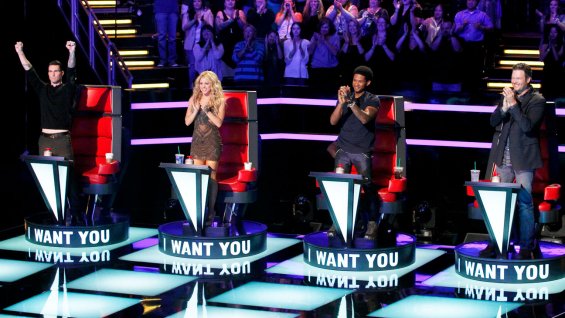Evans 1
Lindsey Evans
English 015
Dr. Jessica O’Hara
21 February 2014
Is Fourth in the World Really That Bad?
In today’s world the pressures placed on Olympic athletes are tremendous. With the invention of television and the expansion of media came an exponential growth in both the athletes’ audiences as well as burdens. From basketball to bobsledding, citizens of a country take a vested interest in the games and see it as a sense of national pride to perform well. Unfortunately, though, this sense of patriotism often clouds the minds of viewers, making the games more about medal counts than shear respect for talent. Even more unfortunately is that this attitude often leaks into the media. One of such instances occurred very recently in the 2014 Sochi Winter Olympic Games in Russia after snowboarder Shaun White’s unexpected performance; though White finished fourth overall, his reputation for being an Olympic star made fans feel disappointed in his failure to make the medal stands. Some news sources say White’s performance was an utter disappointment after the hype leading up to Sochi. Others defend White, blaming his mistakes on the poor conditions of the half pipe on the day of the competition. Two of these articles respectively are the article titled “No medal for Shaun White in Olympic men’s half pipe” from USA Today and “Team America crashes out on ‘c**p’ snow: Shaun White loses out on third half pipe gold after every U.S. snowboarder falls following concerns about course conditions” by Daily Mail. Regardless of the stories behind an article or newscast, however, presentation is key; audiences can only interpret what editors desire them to see in their mind’s eye.
Evans 2
In media as in life, words can be powerful tools. Wars can be avoided with them, they can land you your dream job in an interview, and just four can convince a partner to say “I do.” Words are intended to make an audience form an opinion about a topic, and news stories, no matter how factual they appear, are no exception. In the newscast titled “No medal for Shaun White in Olympic men’s half pipe” from USA Today, the newscaster’s language depicts Shaun White’s Olympic performance as a disaster. Even the title displays this opinion. For example, though half of the newscast is dedicated to White’s apparent failure, the other half recaps the highlights of the day for women’s skiing and luge without any recognition in the story’s title. Although the newscast covers more than just Shaun White, the headline only displays White’s standings to draw attention to his fall from grace. Continuing into the story, the narrator’s specific use of words remains a prominent form of persuasion. Though in written form the article appears as nonbiased, (using less intense verbs and adjectives such as “faltered” and “uncharacteristic mistakes”) the inflections in the newscaster’s voice convey an overall negative connotation to the viewer. Though “faltered” appears to be a somewhat subdued word on the surface, the narrator puts great emphasis on it, making it stand out to the audience as something very important. This happens several other times throughout the newscast, twice when describing White’s specific mistakes (“falling twice and had two bobbles in his second run”) and his late drop of the slope-style event. In the latter, it was too late for another athlete to take White’s place, and the narrator’s tone seems to make White out to be the bad guy, as though he wanted to take the position away from another Olympian. Similarly, though the commentator could have just said that Shaun White finished in fourth place overall- an outstanding achievement for any athlete- he quickly throws in the comment “and without a medal.” By simply adding the conjunction “and” to the statement, the newscaster immediately wipes away the positive feelings associated with such an exceptional performance by one man facing the best
Evans 3
in the world and replaces them with feelings of contempt. One final act of persuasion in the newscast occurs at the very end of White’s coverage. As the story switches from Shaun White’s performance to those of Devin Logan and Erin Hamlin (both medal winners in the 2014 Sochi Olympics), the commentator leads with “but there was good news for Team U.S.A” (No medal for Shaun White). This sharp dismissal of Shaun White from the news story provides a deep contrast for the intended emotions of viewers and blatantly portrays the news story’s opinion that fourth place just was not good enough.
The second article by Daily Mail takes a different approach. In the wordy title “Team America crashes out on ‘c**p’ snow: Shaun White loses out on third half pipe gold after every U.S. snowboarder falls following concerns about course conditions” White’s name appears at the end, almost as an afterthought to belittle the importance of the statement in the overall scheme of the piece. The article is displaying the message that, although White is included, he is not the key emphasis of the text. Instead, the story takes the blame from Shaun White himself (as was the case in the USA Today newscast) for the mistakes and instead places the blame on the article’s main topic: poor conditions on the half pipe. While USA Today only briefly touched on the poor conditions of the half pipe, Daily Mail makes it the main news story. Though Daily Mail makes several comments about White’s disappointing performance, the source ultimately defends the athlete by stating throughout the article that both American and foreign snowboarders had been commenting on the slushiness of the half pipe in advance of the event. The article has facts spread throughout commenting on the high temperatures, the concerns of athletes, and even the steps being taken to improve the conditions. The inclusion of such specifics is intended to make the audience more susceptible to persuasion, as they make the source seem more credible. This is supported through various quotations from the Americans, who referred to the half pipe as “crappy,” “garbage,” and, as White said himself, “pretty hard to
Evans 4
ride.” Also, unlike USA Today, Daily Mail chooses to focus on the performances of all of the competitors in the event (specifically the Americans) rather than solely Shaun White. For example, the article has a small section dedicated to the event’s winner, Switzerland’s Iouri Podladtchikov, and also states that “It is the first time an American has not won a medal since the sport was introduced to the Olympics in 1998.” This fact is quickly followed with a quote from snowboarder Danny Davis- not Shaun White- that they “let America down.” Daily Mail is trying to convey the message that, although snowboarding is an individual event, Team U.S.A. failed as just that: a team. Furthermore, because this is a written article, the author also incorporates the use of strategic punctuation within the piece. In the article’s very first sentence, “Shaun White has failed to defend his title in the men’s snowboard half pipe at Sochi- after he and his teammates crashed out of a course they called ‘crappy’ and ‘garbage’,” the author chose to place dashes between two very distinct ideas (No medal for Shaun White). The first half of the sentence sounds as though the article takes a negative approach, but the dashes are followed by a different reasoning for White’s mishap. As author Heather Holleman refers to in her book, How to Write with Flair, dashes are equivalent to “shouts.” To her, dashes “[stop] the reader and [make] him see something important…that makes a big difference to the meaning of the sentence” (Holleman 42). With the addition of dashes to this sentence, the author changes the audience’s perception of the events that occurred. The author says that Shaun White did fail to defend his title, but only because the half pipe’s conditions were not up to their usual standards. By drawing attention to the second statement, the article manages to persuade readers that the results of Shaun White’s Olympic performance were something beyond his control.
Another key tool of persuasion in the news is imagery. As the common phrase goes, “A picture is worth a thousand words.” This means that an audience is impacted much more emotionally by a picture than any other form of communication. USA Today takes advantage of
Evans 5
this human trait and plays to it with a photograph montage during the newscast about Shaun White’s standings. Instead of showing the newscaster, as many news reports these days are prone to do, this story displays only images of White. Though there are several generic photographs of White in the air on his snowboard, slightly more than half of the images depict either White’s mistakes during his half pipe runs or his agony afterward. Three of the pictures (including the very first image of the newscast) show White looking down at the ground. The most prominent of these is an image of White holding his head in his hands after a run. To the reader, this simple glance and the body language from White convey a negative message of defeat, a message which the commenter bolsters with his narration. Furthermore, after the series of sorrowful images, the story’s pictures take a turn just as the mood does. When discussing the medal wins by Devin Logan and Erin Hamlin, the pictures are noticeably much cheerier. Snapshots of fumbles and frustration are replaced by images of successes and celebrations, thus solidifying the audience’s perceived views of victory and defeat, winners and losers (No medal for Shaun White).
Yet again, however, Daily Mail prefers to show the images from a different angle. Although the same exact photograph of White holding his head in his hands is displayed in this article, the image is joined by images of both Danny Davis and Gregory Bretz, two other American snowboarders, frustrated by falls during their runs. By including these two other images and by displaying White’s image only afterwards, Daily Mail plays on the idea that we are only human. This technique is also used earlier in the piece where a picture of White’s fall is followed immediately by those of his teammates. Daily Mail then continues its happier approach to the events at Sochi by showing pictures of sportsmanship as Shaun White embraces gold medal winner Iourdi Podladtschikov after the scores are announced. These images, in combination with photographs of Podladtschikov celebrating with his family, leave the reader
Evans 6
feeling a great deal more positive about the events at Sochi as the article approaches its conclusion (Warren).
What is it that defines a winner? Though this seems like a relatively straightforward question, take a moment to think about the many different definitions for this word. Some people take a dictionary approach and base it solely off of an athlete’s records. Some people see it as sportsmanship. And still, some people describe it as shear effort and determination. In short, victory has many meanings for different people, making two newscasts about a single event appear very distinct from one another. Shaun White’s Sochi Olympics are a perfect example of one of such cases. From USA Today’s point of view White’s performance at the games is something to be forgotten. On the other hand, Daily Mail defines the moment as a learning experience. Though both newscasts discuss the same exact event, the emotions and conclusions drawn from the audiences could not have been more different. USA Today’s article leaves readers feeling angry with Shaun White for letting down his country while Daily Mail allows readers to sympathize with his mistakes under the circumstances. In the end, however, it is up to the audience to use its own personal values and beliefs to decipher the facts and decide for itself which article’s judgment is right and which is wrong.
Evans 7
Works Cited
Holleman, Ph.D., Heather. How to Write with Flair. Charleston: 2011. 42. Print.
No medal for Shaun White in Olympic men’s halfpipe. USA Today, 2014. Web. 19 Feb 2014.
<http://www.usatoday.com>.
Warren, Lydia. “Team America crashes out on ‘c**p’ snow: Shaun White loses out on third half
pipe gold after every US snowboarder falls following concerns about course conditions.’
Daily Mail. Associated Newspapers, 11 Feb 2014. Web. 19 Feb 2014. <http://www.dailymail.co.uk>.






